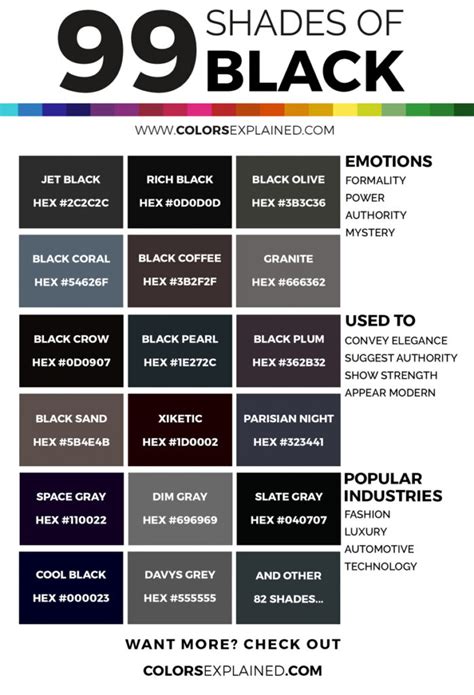Pure jet black is a mesmerizing shade that exudes elegance, power, and sophistication. It is the darkest shade of black, absorbing nearly all visible light and reflecting almost no light. This captivating color has captivated artists, designers, and scientists for centuries, inspiring countless creations and discoveries.

## The Science of Pure Jet Black
Pure jet black arises from the total absorption of light across the entire visible spectrum. This means that it has a very low luminous reflectance, which is measured in percent. The luminous reflectance of pure jet black is typically around 0.5%, making it one of the darkest substances known to humankind.
The material properties that contribute to the extreme darkness of pure jet black include:
- High Density: Dense materials tend to absorb more light than less dense materials.
- Carbon Content: Carbon is an excellent light absorber, and pure jet black materials often have a high carbon content.
- Nanostructure: The nanostructure of a material can also affect its light absorption properties. Some materials with a rough or porous surface can trap light more effectively than smooth surfaces.
## Applications of Pure Jet Black
The unique optical properties of pure jet black have led to its use in a wide range of applications, including:
- Blackbody Radiation: Pure jet black materials are used in blackbody cavities to simulate perfect absorbers for studying thermal radiation.
- Optics: It is used in optical instruments to minimize stray light and improve image quality.
- Camouflage: Military and security personnel use pure jet black materials for camouflage and concealment.
- Art and Design: Artists and designers use pure jet black to create bold and dramatic effects in paintings, sculptures, and architecture.
- Textiles: Blackest black fabrics have emerged with applications in fashion and performance wear.
## Blackest Black Fabrics: A Breakthrough in the Textile Industry
Recent advancements in nanotechnology have led to the development of “blackest black” fabrics, which push the boundaries of darkness even further. These fabrics have a luminous reflectance of less than 0.1%, making them the darkest fabrics ever created. Potential applications include:
- Military and Security: Camouflage and stealth capabilities
- Fashion: High-end clothing and accessories with unparalleled elegance
- Heat Management: Effective heat absorption and dissipation in extreme environments
## Benefits and Drawbacks of Using Pure Jet Black
### Benefits:
- Unparalleled darkness: Absorbs nearly all visible light, enhancing perception of depth and contrast.
- Elegant and powerful: Conveys a sense of sophistication, authority, and mystery.
- Versatile applications: Used in various industries, including art, science, and design.
### Drawbacks:
- Heat absorption: Pure jet black materials tend to absorb heat, which can be a concern in certain applications.
- Fading: Exposure to ultraviolet radiation can cause some pure jet black materials to fade over time.
- Cost: Pure jet black materials can be relatively expensive compared to lighter shades of black.
## Tips and Tricks for Using Pure Jet Black
- Pair with contrasting colors: Pure jet black creates a striking contrast when combined with lighter colors, enhancing visual impact.
- Use texture and patterns: Add depth and interest to pure jet black surfaces by incorporating textures and patterns.
- Accessorize with metallic accents: Metallic accents can complement pure jet black, adding a touch of elegance and luxury.
- Consider the lighting: The appearance of pure jet black can be affected by lighting conditions. Experiment with different light sources to achieve the desired effect.
- Protect from UV exposure: To prevent fading, protect pure jet black materials from prolonged exposure to ultraviolet radiation.
## Questions to Ask Customers for Feedback
To better understand customer perspectives on pure jet black, consider asking the following questions:
- What are the most appealing qualities of pure jet black to you?
- How would you like to see pure jet black used in new applications?
- What are the potential challenges or concerns you have about using pure jet black?
- What do you think are the most important factors to consider when choosing a pure jet black material?
## Generating New Applications for Pure Jet Black
To generate ideas for new applications of pure jet black, consider the following “Tips and Tricks”:
- Combine with technology: Explore ways to integrate pure jet black with advanced technologies, such as optics, electronics, and nanotechnology.
- Seek inspiration from nature: Look to nature for examples of how jet black is used in camouflage, temperature regulation, and light absorption.
- Brainstorm with experts: Collaborate with experts in different fields, such as scientists, designers, and industry professionals, to generate innovative ideas.
## Tables
### Table 1: Properties of Pure Jet Black Materials
| Property | Value |
|---|---|
| Luminous Reflectance | < 0.5% |
| Density | > 2.0 g/cm³ |
| Carbon Content | > 99% |
| Nanostructure | Rough or Porous |
### Table 2: Applications of Pure Jet Black
| Application | Industry |
|---|---|
| Blackbody Radiation | Physics |
| Optics | Instrumentation |
| Camouflage | Military, Security |
| Art and Design | Art, Design |
| Blackest Black Fabrics | Textiles |
### Table 3: Benefits of Using Pure Jet Black
| Benefit | Description |
|---|---|
| Unparalleled Darkness | Absorbs nearly all visible light |
| Elegant and Powerful | Conveys sophistication, authority |
| Versatile Applications | Used in various industries |
### Table 4: Drawbacks of Using Pure Jet Black
| Drawback | Description |
|---|---|
| Heat Absorption | Can absorb excessive heat |
| Fading | Exposure to UV can cause fading |
| Cost | Can be relatively expensive |
